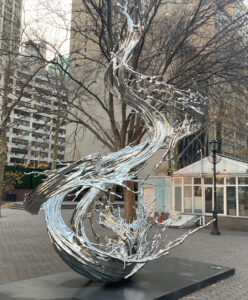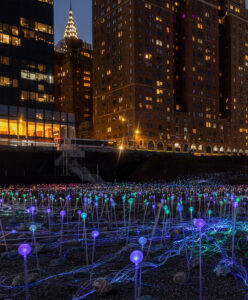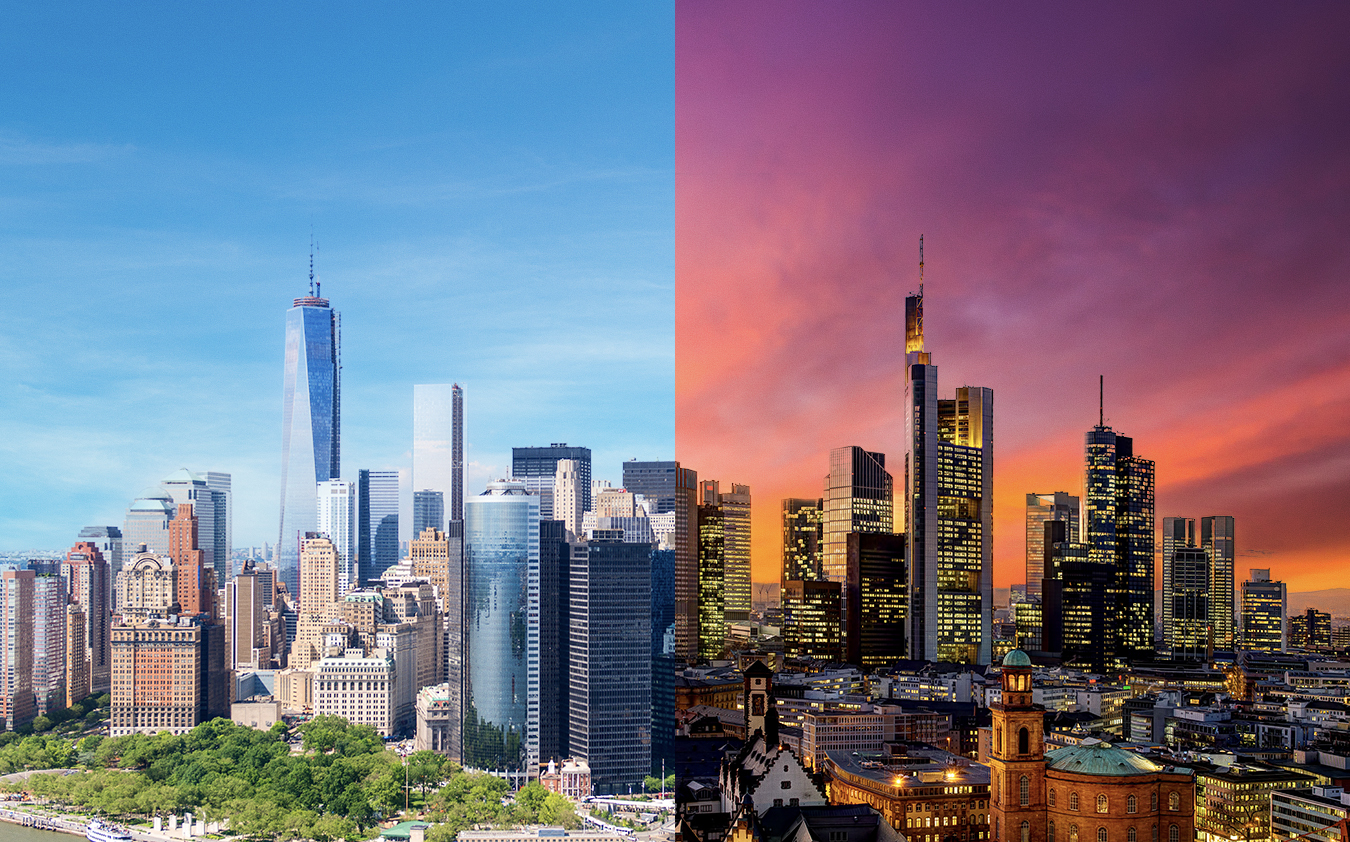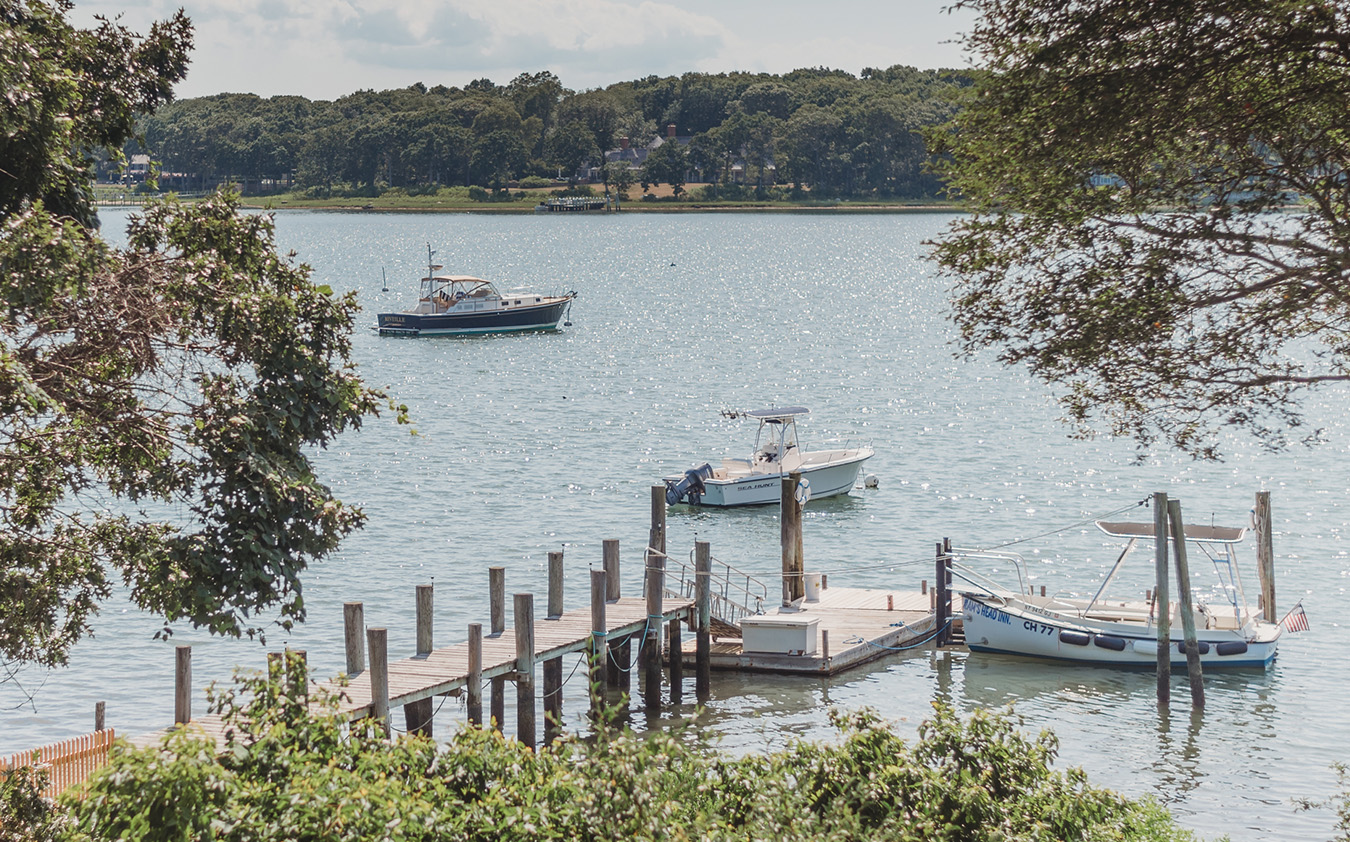
Six Public Artworks to See Admission-Free in NYC
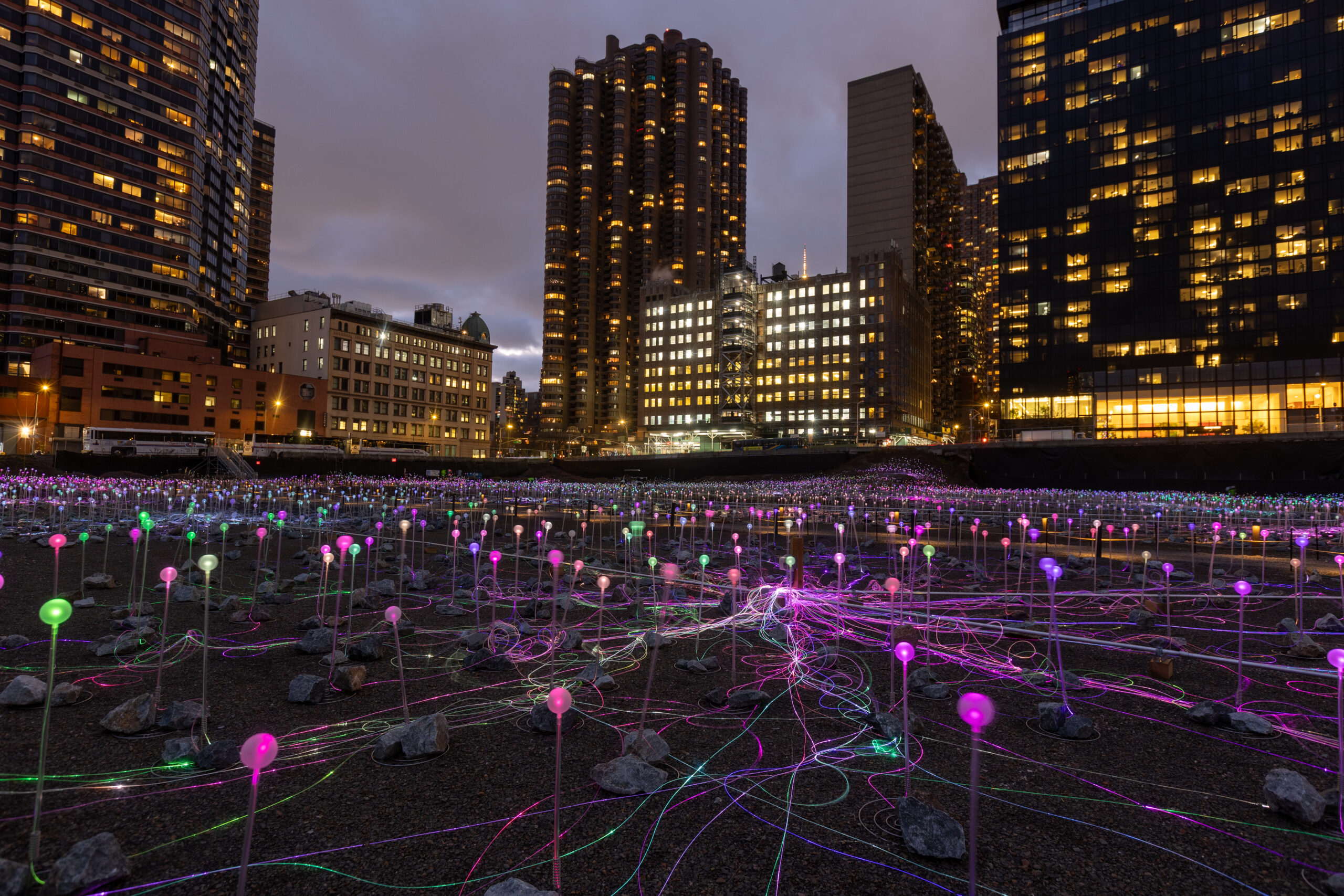
These installations by notable artists are accessible to all.
Public artworks aren’t just decorative accessories for parks and plazas, but rather defining features of such spaces. New York’s public artworks appear on roofs and ceilings, in office building lobbies and even embedded in the sidewalks. Some works are figurative and realistic, others abstract and minimalist in nature, some are set on plinths while others meet you at eye level. But they are all so integral to the cityscape that the very fabric of New York we know and experience would be far diminished without these pieces. Such works are often easy to overlook on the (mostly) frenetic Manhattan streets, but I encourage you to look for them and to stop. See what they depict and how they animate the space they occupy. Each is an artwork for everyone.
Undercurrent | Zheng Lu (2023) | Dag Hammarskjold Plaza
Even though the waters of the East River are visible from the end of Midtown East‘s Dag Hammarskjold Plaza, it’s the flow of the natural element as rendered in stainless steel by the artist Zheng Lu that people really notice. A cascade of flowing “water” appears to be cresting mid air, one of the several works in the Chinese artist’s “Water in Dripping” series, each meant to highlight the necessity of the increasingly limited resource. Although this work, part of the NYC Parks Department’s Art in the Parks series, is on view until August 2024, there is nothing ephemeral about the message it sends. This is one of those new public artworks that really gets people to stop and to admire — and to think about what it represents. While its effect is strong at any time of day, its gleaming form comes to life in the morning when the rising sun illuminates the polished surface and again at sunset, when the last rays from the west light up the “water”, which appears both fluid and solid at the same time.
Field of Light (2024) | Bruce Munro | Freedom Plaza
Upon approaching the ‘Field of Light,’ it suddenly feels as if you’re flying high above a big city, with its network of lights spreading out into all directions. Other visitors to the new temporary public artwork by Bruce Munro remark that the vista of 18,750 LED light spheres arrayed over a six-acre site on Manhattan’s East Side is like viewing a galaxy of stars. Whatever the allusion and illusion, the sight of the multicolored lights is as exhilarating as Manhattan’s other nightly light show — the skyline at night. What was once the site of a giant power plant is now an empty field, prior to some future development. The Soloviev Foundation had the idea to commission a public artwork for the fallow site, to transform it into a destination. While the whole of the spectacle can be viewed easily from First Avenue, between 41st Street and 38th Street, another experience of it can be had by following a trail that meanders through the blaze of light. (Free tickets can be reserved online).
Bust of Sylvette | Pablo Picasso x Carl Nesjar (1968) | University Village
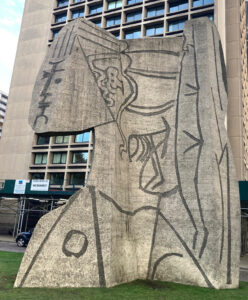 Just as Dante was fixated on his Beatrice and Lewis Carroll on his Alice, Picasso had his Sylvette, a young woman he met on trip to France and who became a kind of de facto muse for him for decades. His biggest homage to her is this 60-ton, 36-foot-high version of her at the crossroads of SoHo, NoHo, and Greenwich Village, composed of compressed pebbles, Norwegian black granite, and rock from the Hudson Valley — all affixed around a metal armature. Once the materials were in place, a concrete skin was applied over the rock mass. An image of Sylvette, complete with her long ponytail, was sandblasted onto the concrete form by Norwegian sculptor Carl Nesjar, who Picasso had hired for the task. I.M. Pei’s three handsome and decidedly Modernist housing towers (for NYU faculty) backdrop Sylvette, who also functions as a frequent soccer ball wall for young residents of the buildings.
Just as Dante was fixated on his Beatrice and Lewis Carroll on his Alice, Picasso had his Sylvette, a young woman he met on trip to France and who became a kind of de facto muse for him for decades. His biggest homage to her is this 60-ton, 36-foot-high version of her at the crossroads of SoHo, NoHo, and Greenwich Village, composed of compressed pebbles, Norwegian black granite, and rock from the Hudson Valley — all affixed around a metal armature. Once the materials were in place, a concrete skin was applied over the rock mass. An image of Sylvette, complete with her long ponytail, was sandblasted onto the concrete form by Norwegian sculptor Carl Nesjar, who Picasso had hired for the task. I.M. Pei’s three handsome and decidedly Modernist housing towers (for NYU faculty) backdrop Sylvette, who also functions as a frequent soccer ball wall for young residents of the buildings.
Flight | Richard Lippold (1963) | MetLife Building
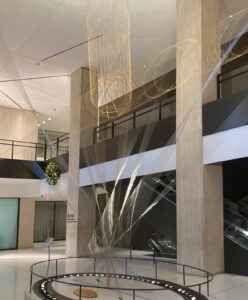 Richard Lippold’s favorite sculpting material was air. Many of his sculptures that are composed of floating elements are, indeed, more about what is not there than what is. When he was commissioned to design a sculpture for the 44th Street side of what was then known as the Pan Am Building (now MetLife), he sought to replicate the idea of airline flights by stringing some 10,000 stainless steel strands of wire across a two-story-high space, and then illuminating them. When caught in the ceiling lights, his funnels of steel wires, with others made of 22-karat gold and bronze, appear to evoke the winds of the world, as well as the shapes of modern aircraft, and even the flight paths commercial airlines follow. Although Pan Am Airways has long been grounded, Lippold’s sculpture continues to take flight.
Richard Lippold’s favorite sculpting material was air. Many of his sculptures that are composed of floating elements are, indeed, more about what is not there than what is. When he was commissioned to design a sculpture for the 44th Street side of what was then known as the Pan Am Building (now MetLife), he sought to replicate the idea of airline flights by stringing some 10,000 stainless steel strands of wire across a two-story-high space, and then illuminating them. When caught in the ceiling lights, his funnels of steel wires, with others made of 22-karat gold and bronze, appear to evoke the winds of the world, as well as the shapes of modern aircraft, and even the flight paths commercial airlines follow. Although Pan Am Airways has long been grounded, Lippold’s sculpture continues to take flight.
Women’s Rights Pioneers Monument | Meredith Bergmann (2020) | Central Park
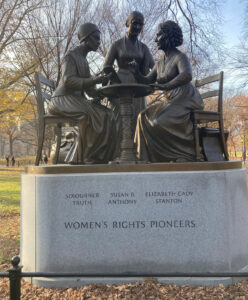 While visitors to Central Park can take in depictions of Mother Goose and Alice in Wonderland and Juliet (of Shakespeare fame), the first depictions of real women weren’t unveiled here — near the entrances at E. 67th and E. 69th streets, on the Upper East Side — until 2020, on the 100th anniversary of the ratification of the 19th Amendment, which allowed women the right to vote. Among the most active advocates for women’s rights were Sojourner Truth, Susan B. Anthony, and Elizabeth Cady Stanton. While they are shown together, engaged in lively discourse, the three were rarely actually together, though they were simultaneously active in various civil rights and suffragist issues at the same time. The three figures, rendered in bronze, loom larger-than-life size. They attract visitors in ways that the park’s others do not, perhaps in part because the women are in such lively (if slightly argumentative) discourse, given their occasionally differing views of suffragism, and maybe also because real women are finally shown as prime American history makers.
While visitors to Central Park can take in depictions of Mother Goose and Alice in Wonderland and Juliet (of Shakespeare fame), the first depictions of real women weren’t unveiled here — near the entrances at E. 67th and E. 69th streets, on the Upper East Side — until 2020, on the 100th anniversary of the ratification of the 19th Amendment, which allowed women the right to vote. Among the most active advocates for women’s rights were Sojourner Truth, Susan B. Anthony, and Elizabeth Cady Stanton. While they are shown together, engaged in lively discourse, the three were rarely actually together, though they were simultaneously active in various civil rights and suffragist issues at the same time. The three figures, rendered in bronze, loom larger-than-life size. They attract visitors in ways that the park’s others do not, perhaps in part because the women are in such lively (if slightly argumentative) discourse, given their occasionally differing views of suffragism, and maybe also because real women are finally shown as prime American history makers.
Big Red Swing | Theodore Ceraldi (1969) | 777 Third Avenue
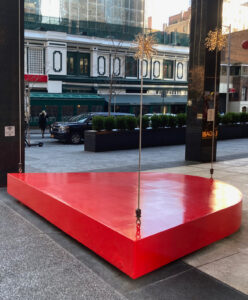 Take a seat. It’s allowed, especially now that Theodore Ceraldi’s swing is back from its recent paint job. Both sculpture and public amenity, his 8 1/2 -foot perch is suspended beneath an office building arcade, not unlike a real swing at a playground. While the red platform pivots back and forth, don’t expect to be soaring high above the skyscrapers, though this is a contemplative place to pause and watch the traffic pass on Third Avenue. The late real estate developer Melvyn Kaufman acted as a kind of benefactor for young artists making public works. When he developed this rather undistinguished office tower, he gave students at The Cooper Union the chance to create something for the space. Ceraldi, a student there at the time, won the competition with a series of granite boulders to be placed on the sidewalk, but their weight proved too much. Undeterred, he resubmitted what is now in place. The swing is shaped like a grand piano, its shape echoed just in front by a planter containing a mini grove of gingko trees. When sitting on the swing, you become as much a work of art as the object itself.
Take a seat. It’s allowed, especially now that Theodore Ceraldi’s swing is back from its recent paint job. Both sculpture and public amenity, his 8 1/2 -foot perch is suspended beneath an office building arcade, not unlike a real swing at a playground. While the red platform pivots back and forth, don’t expect to be soaring high above the skyscrapers, though this is a contemplative place to pause and watch the traffic pass on Third Avenue. The late real estate developer Melvyn Kaufman acted as a kind of benefactor for young artists making public works. When he developed this rather undistinguished office tower, he gave students at The Cooper Union the chance to create something for the space. Ceraldi, a student there at the time, won the competition with a series of granite boulders to be placed on the sidewalk, but their weight proved too much. Undeterred, he resubmitted what is now in place. The swing is shaped like a grand piano, its shape echoed just in front by a planter containing a mini grove of gingko trees. When sitting on the swing, you become as much a work of art as the object itself.


